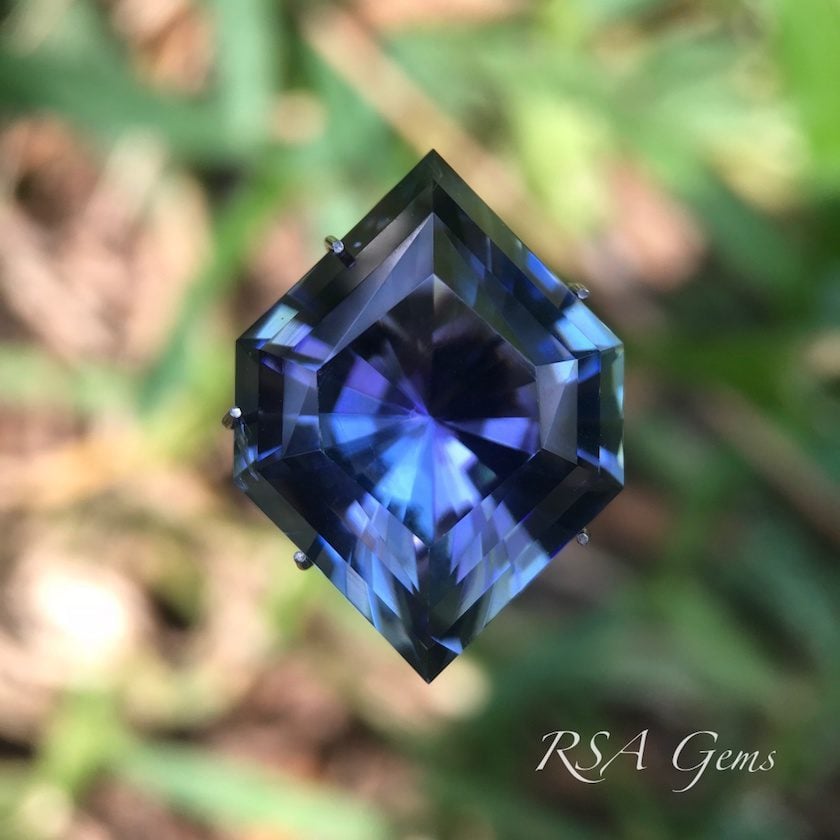How to Choose a Gemstone Shape for Cutting
How do lapidaries decide what gemstone shape to cut? Learn how inclusions, rough, orientation, and other factors can influence that decision.
2 Minute Read
Dealing with Inclusions
In natural stones, inclusions present the most significant obstacles for gem cutters. It's not always possible to remove all inclusions from a rough stone during cutting. However, allowing them to remain where they break through the surface of the stone, particularly along the girdle, may result in a weaker, less durable gem.
Letting the Rough Suggest the Gemstone Shape
Sometimes, a rough stone has such an obvious shape that cutting it otherwise would be foolish. Take a look at the following two pairs of photos of rough and cut stones. You'll probably agree with the choices I made.
All gems cut by Loren Brown. All photos © RSA Gems. Used with permission.
Orientation May Suggest a Different Gemstone Shape
The first step to cutting a stone is orienting it so you can dop it and begin faceting. This is probably the most important step in the cutting process because it determines the color, size, and shape of the finished stone.
Once you choose an orientation, you'll remove surface inclusions from around the perimeter (which will become the girdle). Sometimes, this process will suggest a different shape than you originally planned. At this stage, you can input the gemstone shape in a computer design program such as GemCad or Gem Cut Studio. You'll get a design that will best match the actual outline of the stone.
One-of-a-Kind or Traditional Shapes?
Proceeding in this fashion can produce some unusual, striking, and sometimes one-of-a-kind shapes, and they sell surprisingly well. There are collectors and jewelers who appreciate these eclectic designs because no one else will have one quite like it.
All gem designs and cuts by Loren Brown. All photos © RSA Gems. Used with permission.
This approach provides unlimited design options. However, a word of caution is in order. When cutting expensive material, you may find it prudent to stick to more traditional shapes. For example, a high-end stone cut in a traditional pattern may sell faster than an asymmetrical design.
On the other hand, you may still be able to provide an unusual shape while retaining a high degree of symmetry. In cutting the tanzanite below, I had to cut the left to remove a large inclusion. (A small part of the inclusion remains, but it doesn't touch the girdle or break the surface of the gem). So, I cut the right side to match, retaining the stone's symmetry.
The Artist's Responsibility
Gemstones can take millions of years to form and may lie buried for millions or even hundreds of millions of years more. Ultimately, you — the artist — have the responsibility to bring out the most beautiful result you can from these natural wonders.
Loren Brown, RSA Gems
Loren Brown received his Bachelor’s degree in Aerospace Engineering from State University of New York at Buffalo in 1986. After a 30-year career as an aerospace and mechanical engineer, he decided to re-invent himself with a longtime favorite hobby as a gemstone artist. Establishing RSA Gems in 2017 gave him an opportunity to combine his passion for science, gemstones, and art. His self-taught faceting style brings uniqueness to his gem pieces. RSA Gems is a family-owned business that delivers exceptional natural gemstones. Precision faceting and the use of only natural, untreated, raw material makes his company distinctive in the modern gemstone industry.
Related Articles
Common Books About Stones and Faceting
How to Facet Gems
Faceting Made Easy, Part 4: Pavilion Cutting and Polishing
Faceting Made Easy, Part 1: Gemstone Properties
Latest Articles
800 Years of Mogok: A Celebration in Tenuous Times
What is the Average Gemstone Faceting Yield?
Pyroxmangite Value, Price, and Jewelry Information
How to Identify Emerald Simulants and Synthetics
Never Stop Learning
When you join the IGS community, you get trusted diamond & gemstone information when you need it.
Get Gemology Insights
Get started with the International Gem Society’s free guide to gemstone identification. Join our weekly newsletter & get a free copy of the Gem ID Checklist!
